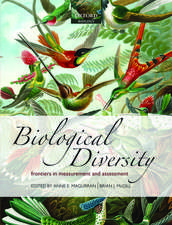Air Pollution: Dimensions, Trends and Interactions with a Forest Ecosystem
Autor Walfried Michaelisen Limba Engleză Paperback – 16 sep 2011
Preț: 635.47 lei
Preț vechi: 747.61 lei
-15% Nou
Puncte Express: 953
Preț estimativ în valută:
121.61€ • 125.63$ • 101.21£
121.61€ • 125.63$ • 101.21£
Carte tipărită la comandă
Livrare economică 26 martie-09 aprilie
Preluare comenzi: 021 569.72.76
Specificații
ISBN-13: 9783642644146
ISBN-10: 3642644147
Pagini: 196
Ilustrații: XII, 178 p. 2 illus. in color.
Dimensiuni: 155 x 235 x 10 mm
Greutate: 0.28 kg
Ediția:Softcover reprint of the original 1st ed. 1997
Editura: Springer Berlin, Heidelberg
Colecția Springer
Locul publicării:Berlin, Heidelberg, Germany
ISBN-10: 3642644147
Pagini: 196
Ilustrații: XII, 178 p. 2 illus. in color.
Dimensiuni: 155 x 235 x 10 mm
Greutate: 0.28 kg
Ediția:Softcover reprint of the original 1st ed. 1997
Editura: Springer Berlin, Heidelberg
Colecția Springer
Locul publicării:Berlin, Heidelberg, Germany
Public țintă
ResearchCuprins
1 Introduction.- References.- 2 The Investigation Site.- References.- 3 Research Concept and Coordination.- References.- 4 General Outline of the Measuring Station.- References.- 5 Experimental Procedures.- 5.1. Sampling Techniques.- 5.2 Analytical Techniques.- References.- 6 Methodology for the Determination of Atmospheric Deposition and of Fluxes within the Ecosystem Compartments.- 6.1 Basic Considerations on Dry Deposition.- 6.2 Aerosol Measurements.- 6.3 Turbulent Fluxes in the Boundary Layer.- 6.4 Fluxes in the Stand and the Seepage Water.- References.- 7 Trace Elements in Rainwater: Concentrations and Wet Deposition.- 7.1 Concentrations of Dissolved and Particulate Constituents.- 7.2 Wet Deposition.- References.- 8 Deposition of Anions and Cations Via Precipitation.- 8.1 Meteorology and Source-Receptor Relationship.- 8.2 Deposition of SO42-, NO3-, Cl-, F- and NH4+: Mean Values, Temporal Variations and Long-Term Trends.- 8.3 pH Values and H+-Ion Deposition.- References.- 9 Trace Elements in Size-Fractionated Particulates: Concentrations and Dry Deposition into a Forest Ecosystem.- 9.1 Differential Trace Element Concentrations.- 9.2 Dry Deposition of Trace Elements.- References.- 10 Total Deposition of Trace Elements.- References.- 11 Element Supply and Element Fluxes in the Forest Ecosystem Compartments.- 11.1 Element Supply in the Mineral Soil and the Humus Layer.- 11.2 Biomass and Element Content in the Tree Compartments.- 11.3 Balance of Element Fluxes.- References.- 12 Concentrations and Deposition of Gaseous Pollutants: SO2, NO2, NO, NH3 and O3.- 12.1 Gas Concentrations and Weather Conditions.- 12.2 Mean Values, Temporal Variations and Long-Term Trends of the Gas Concentrations.- 12.3 Nocturnal Ozone Maxima.- 12.4 Dry Deposition: Mean Values, Temporal Variations and Long-Term Trends.- 12.5 Deposition Velocities.- References.- 13 Impact of Gaseous Pollutants on the Forest Ecosystem.- 13.1 Interrelations Between the Concentrations of Pollutants and Carbon Dioxide.- 13.2 Associated Vertical Fluxes.- References.- 14 Summary and Conclusions.- References.










